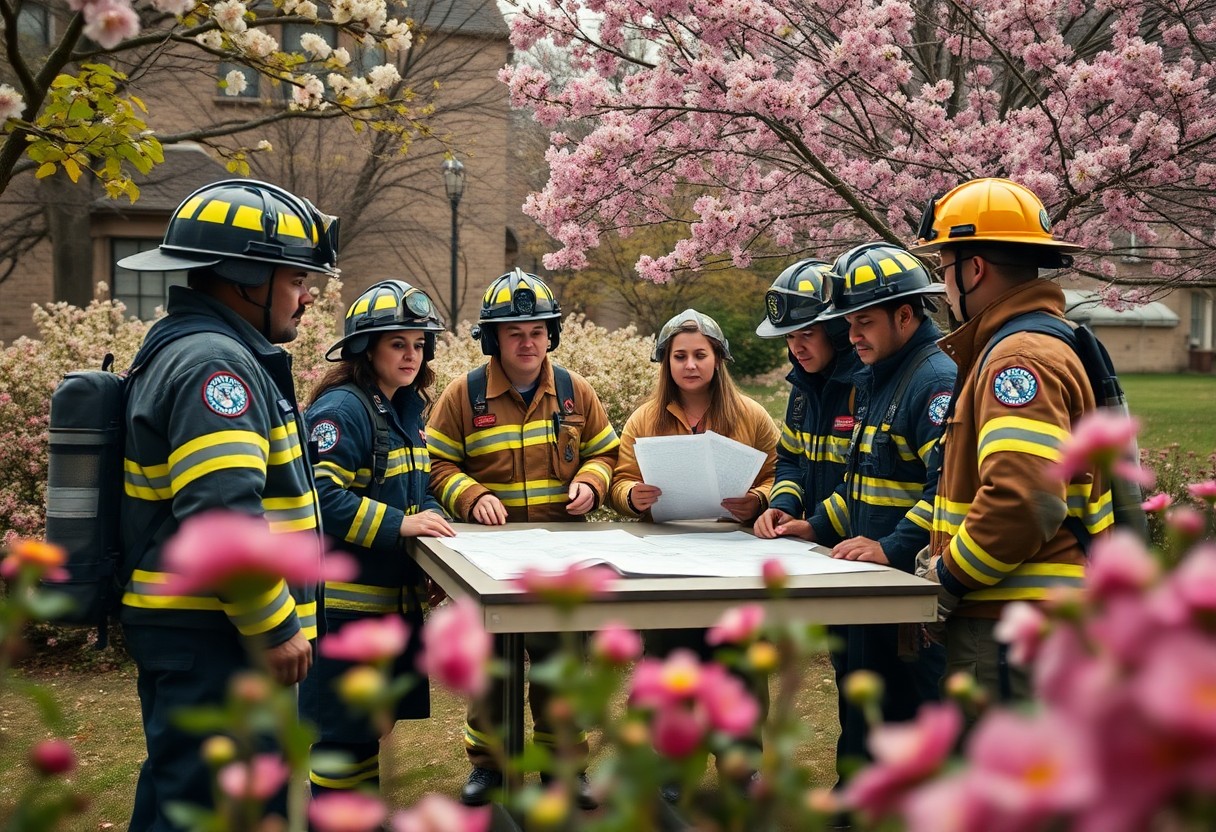Most communities rely heavily on volunteer fire departments to manage emergency situations effectively, especially as spring brings unique hazards like wildfires and flooding. As a member of your local department, it’s imperative that you understand key strategies that can enhance your response to emergencies. This post will guide you through the vital considerations that will help you improve your community’s readiness and ensure that your team can act swiftly and efficiently when it matters most.
How-To Develop Effective Emergency Strategies
Achieving effective emergency strategies involves a thorough understanding of your community’s unique risks and needs. Engage with community members, local leaders, and health professionals to identify key threats, such as natural disasters or potential hazards. Once these needs are recognized, prioritize them, ensuring that your volunteer fire department can respond swiftly and efficiently to any emergency that arises this spring.
Identifying Community Needs
Some of the most pressing community needs can be identified through surveys, public meetings, and discussions with local agencies. By actively engaging with residents, you can uncover their concerns and the specific incidents that have impacted them in the past. This input is invaluable for tailoring emergency strategies that resonate with the community’s expectations and requirements.
Assessing Resource Availability
If you are developing emergency strategies, it is necessary to assess the resources available in your community. Understanding what equipment, personnel, and support systems you have at your disposal enables you to create realistic and actionable plans for emergencies.
Another important aspect of assessing resource availability is conducting an inventory of your fire department’s equipment, training capacity, and volunteer readiness. This process helps identify gaps and challenges that may hinder your operations during emergencies. Consider also the availability of mutual aid agreements, as these partnerships can provide additional resources in times of need. By analyzing these aspects, you can better prepare your team for effective response efforts while also addressing any immediate needs that your community has expressed.
Tips for Engaging Volunteers
If you want to successfully engage your volunteers, consider the following strategies:
- Communicate clearly and regularly.
- Provide opportunities for involvement.
- Show appreciation for their efforts.
- Encourage feedback to foster collaboration.
- Create a positive team environment.
These actions can significantly increase your volunteer morale and commitment. Thou shall recognize that engaged volunteers are vital for your community’s readiness and response capabilities.
Recruitment Techniques
Now, focus on diverse recruitment techniques to attract a wide array of volunteers. Reach out within your community through local events, social media platforms, and partnerships with schools or businesses. Leverage personal networks and emphasize the benefits of joining your volunteer fire department, including skill acquisition and community impact.
Training and Retention Best Practices
Even an effective training program is imperative for retaining volunteers within your fire department. Ensure each member receives comprehensive training to build their confidence and competence. Regularly schedule drills, workshops, and refresher courses to keep skills sharp. Furthermore, create mentorship opportunities, allowing experienced members to guide newer volunteers, thereby fostering a strong community bond.
Engaging your volunteers requires not only effective training but also creating a sense of belonging. Provide clear guidance and ongoing support tailored to individual needs and skills. Emphasize the importance of teamwork in emergencies and share success stories that showcase the critical role volunteers play in saving lives and making a difference. By cultivating an inclusive environment that supports personal development and recognizes achievement, you significantly enhance volunteer satisfaction and retention.
Factors to Consider in Planning
There’s a multitude of factors to consider when developing effective emergency strategies for your volunteer fire department. It’s vital to assess community needs, integrate available resources, and prioritize training programs. Additionally, establishing clear communication channels will enhance coordination during emergencies. Perceiving these aspects early on can significantly improve your preparedness efforts.
Local Hazards and Risks
Even in seemingly tranquil areas, various local hazards can pose significant risks. Assess factors such as wildfires, flooding, or hazardous materials in your community. Understanding these risks allows you to tailor your emergency strategies accordingly, ensuring that your department is prepared for potential emergencies relevant to your specific environment.
Coordination with Other Agencies
Now is the time to emphasize the importance of coordination with other local emergency response agencies. Establish relationships with police, medical services, and community organizations to create a unified approach to emergency management. Collaboration strengthens responses by sharing resources and expertise, ultimately enhancing overall community safety.
Another significant aspect to consider is the value of mutual aid agreements. These agreements allow your department to receive support from surrounding agencies during major incidents, bolstering response efforts. Engaging in regular meetings with partners ensures everyone is aligned and aware of their respective roles. By fostering these connections and communication, you can enhance the level of service provided to your community and uphold a relentless commitment to safety and preparedness.
How-To Implement Communication Systems
Despite the challenges posed by emergency situations, establishing effective communication systems within your volunteer fire department is crucial. You should prioritize the integration of both traditional and modern technology, ensuring all members can receive and disseminate vital information swiftly. This includes regular training exercises to familiarize your team with the systems and ensuring all personnel have access to necessary devices and applications.
Establishing Alert Protocols
One effective way to streamline communication is by establishing clear alert protocols that all members understand and can follow during emergencies. This involves defining how and when alerts should be communicated, who is responsible for sending them, and what channels to use, such as radio, phone calls, or text messages. Consistent drills will help ensure that everyone knows their role during a crisis.
Utilizing Social Media Effectively
Now, leveraging social media can significantly enhance your communication strategy. By creating dedicated pages or groups, you can share timely updates, safety information, and community alerts with your audience. Engaging with your community through these platforms fosters trust and keeps citizens informed of potential risks, such as weather conditions or local emergencies.
For instance, posting regular updates about fire safety tips, upcoming training sessions, or community events can keep your audience engaged. Additionally, during emergencies, immediate updates on containment efforts or specific areas to avoid can help ensure public safety. Encourage your followers to share important posts, as this can amplify your messaging and reach a wider audience. Ultimately, an active social media presence will not only inform the community about your department’s activities but also cultivate a stronger sense of connection and preparedness.
Tips for Evaluating Emergency Response
Now is the time to assess your community’s emergency response capabilities. Evaluating your performance is important for continuous improvement. Here are some key considerations:
- Analyze response times to incidents
- Review communication effectiveness
- Assess the adequacy of resources and equipment
- Engage in post-event debriefing sessions
Thou can significantly strengthen the effectiveness of your community’s emergency strategies by consistently evaluating your response measures.
Conducting Regular Drills
One of the most effective ways to enhance your emergency response is through consistent and realistic drills. Regular practice sessions allow you and your team to familiarize yourselves with various scenarios, ensuring everyone understands their roles and responsibilities. A well-planned drill can expose potential weaknesses in your response procedures and highlight areas that require further training.
Gathering Feedback from Participants
From the outset, it’s vital to collect feedback from participants involved in emergency drills and responses. Effective communication encourages team members to share their insights and suggestions based on personal experiences, enhancing overall performance in future situations.
To gather meaningful feedback, create a structured process where participants can openly express their thoughts. Utilize anonymous surveys or hold feedback sessions to discuss what went well and what challenges arose. Focus on the most critical aspects, such as response times, communication skills, and resource adequacy. Positive insights can boost morale, while identifying dangerous gaps in procedures can lead to necessary adjustments for improved safety in future emergencies.
Factors Influencing Budget Decisions
Not all budget decisions are straightforward, and several factors need to be carefully considered. Key influences include:
- Operational costs
- Equipment maintenance
- Staff training
- Community engagement initiatives
- Emergency response capabilities
This intricate balance determines how effectively your department can respond to emergencies throughout the spring season.
Understanding Funding Sources
To secure the necessary funds for your volunteer fire department, it’s important to identify various funding sources. These can include state and federal grants, local government allocations, fundraising events, and community donations. By exploring all available avenues, you can better support your department’s operational goals.
Prioritizing Resource Allocation
Understanding how to prioritize resource allocation ensures your department remains effective. This involves assessing your department’s immediate operational needs against long-term goals, allowing you to allocate funding wisely and maximize your resources. Prioritizing the purchase of necessary equipment, investing in necessary training, and responding to community feedback are key components of this process.
Decisions regarding prioritizing resource allocation can significantly impact your fire department’s performance. By focusing on immediate needs, such as maintaining vital equipment and training personnel, you enhance your department’s readiness. Additionally, engaging with the community can yield valuable insights into what resources are necessary for effective responses. Balancing short-term needs with long-term investments ensures that you are prepared for any emergencies that may arise.
Final Words
Taking this into account, it’s important that you prioritize effective communication, training, and resource management when developing community emergency strategies for your volunteer fire department this spring. Engaging with local stakeholders and fostering a culture of preparedness can significantly enhance your team’s response capabilities. Additionally, adapting your plans to reflect seasonal challenges will ensure that you are well-equipped to serve your community effectively. By implementing these considerations, you can strengthen your department’s resilience and readiness in the face of emergencies.
FAQ
Q: What are some effective methods for engaging community members in developing emergency strategies for volunteer fire departments this spring?
A: Engaging community members effectively can be achieved through various approaches. Hosting public forums or community meetings can encourage open dialogue about safety concerns and strategies. In addition, utilizing social media platforms to share information and gather feedback allows for broader participation. Collaborations with local schools, businesses, and organizations can also create a strong network for sharing resources and ideas. Lastly, providing workshops or training sessions can empower community members to take an active role in emergency preparedness initiatives.
Q: How can volunteer fire departments assess the specific needs of the communities they serve when planning emergency strategies?
A: Conducting thorough assessments of community needs involves gathering data on demographics, risk factors, and past incident reports. Surveys can provide valuable insight into community concerns and areas where preparation is lacking. Partnering with local emergency management agencies can enhance understanding of existing threats and resources. It’s also beneficial to consider feedback from previous emergency responses to identify gaps and areas for improvement. Engaging with community leaders and organizing focus groups can further help tailor strategies to the unique characteristics of the area.
Q: What role does training and preparedness play in the development of community emergency strategies within volunteer fire departments?
A: Training and preparedness are fundamental components of effective community emergency strategies. Regular training sessions for volunteers ensure that they are well-equipped with the latest skills and knowledge required to respond to emergencies. In addition, community drills and exercises can enhance coordination between volunteers and local agencies, allowing for more effective response in real situations. Educating the community on emergency procedures and safety measures also empowers individuals to act confidently during crises. Continuous evaluation of training programs can help identify areas for improvement, ensuring both volunteers and community members are prepared for emergencies.



